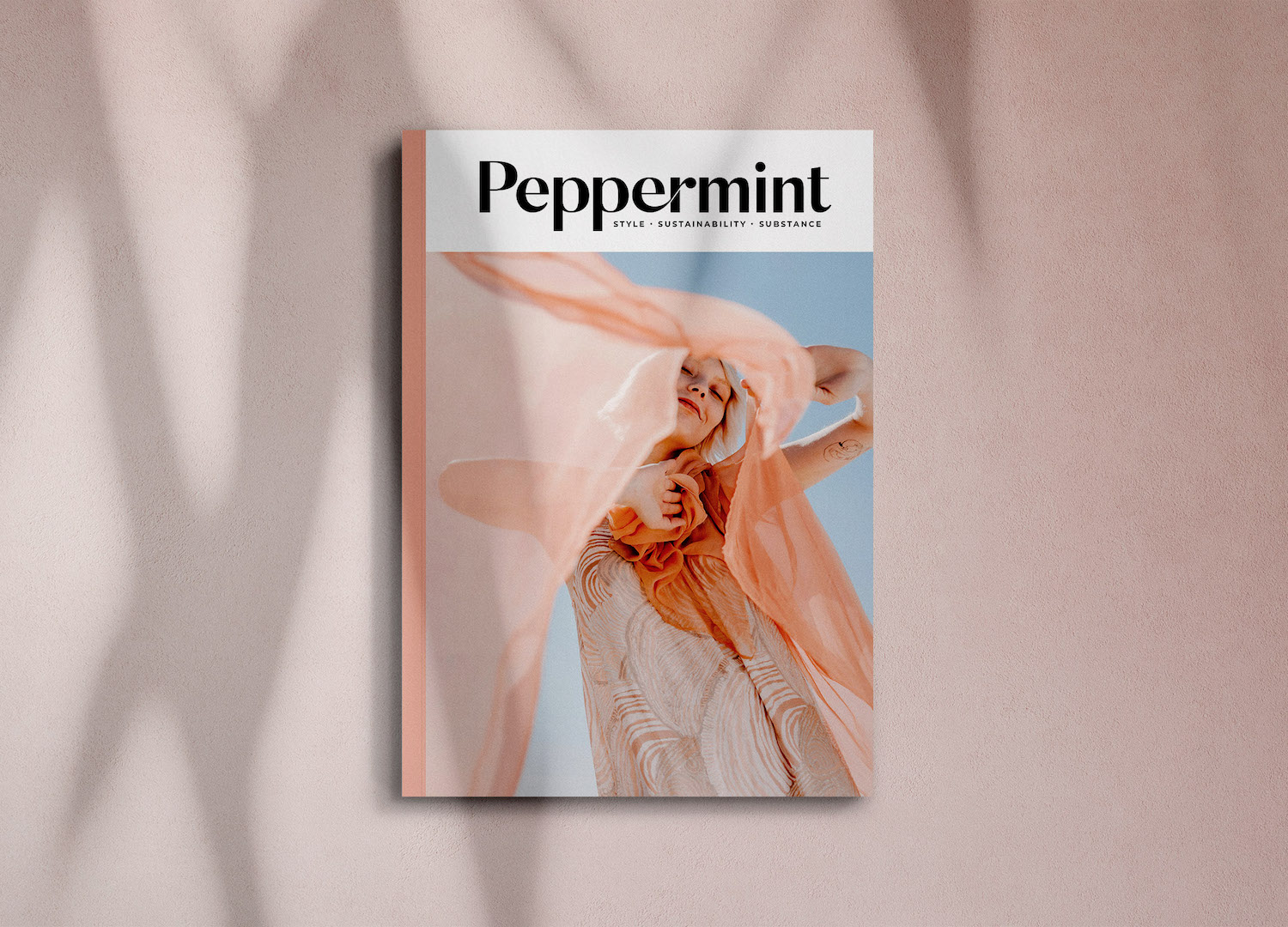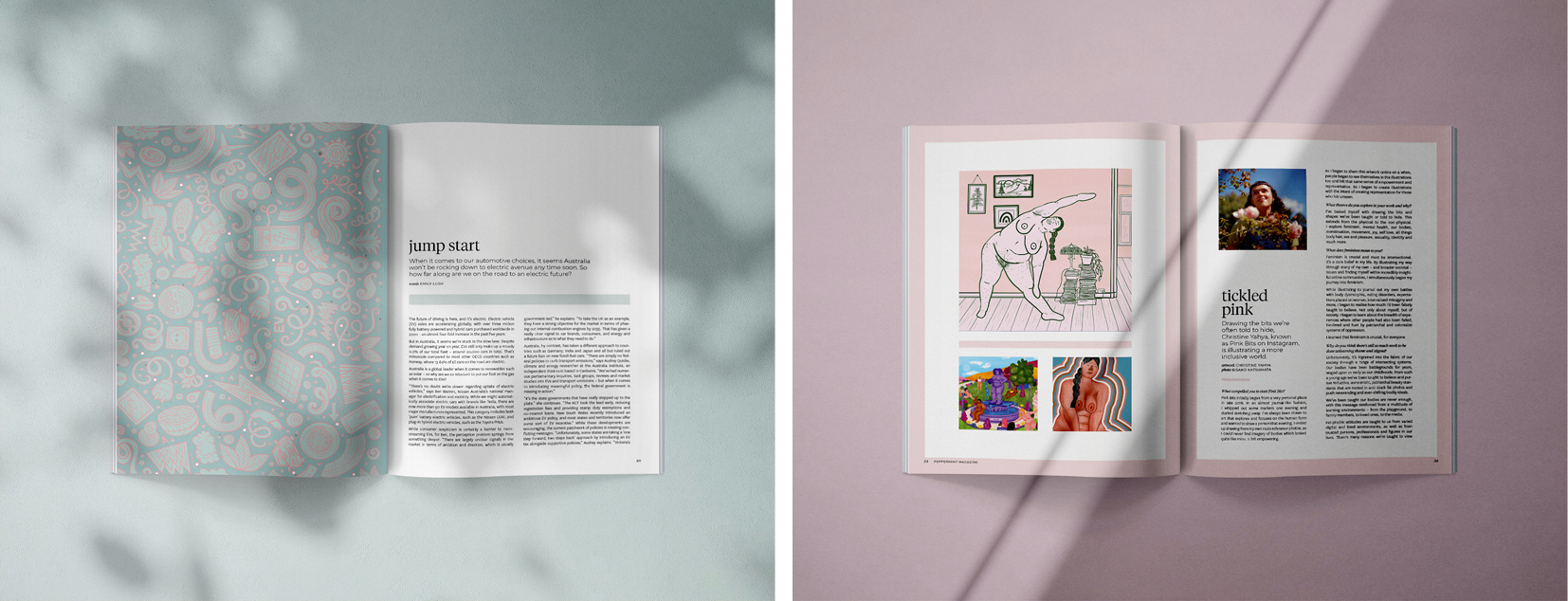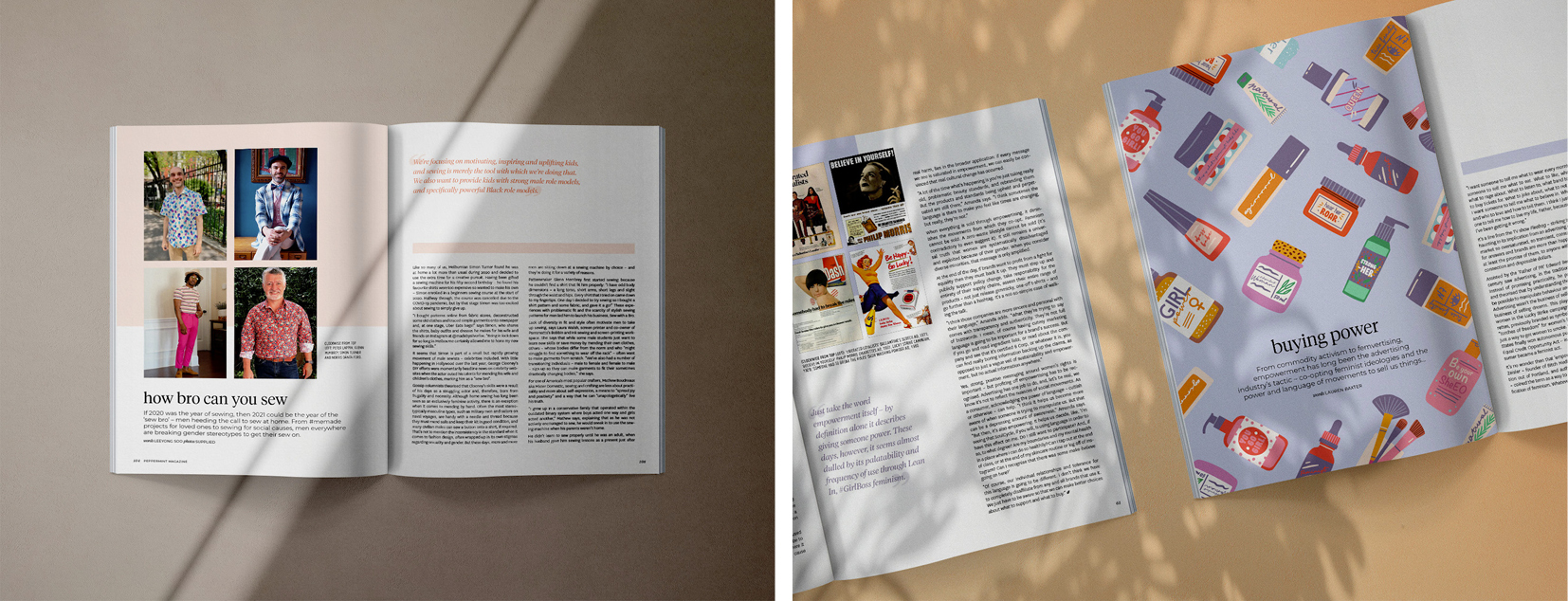
Spring Has Sprung! And With It, Our Gorgeous New Issue
Our dreamy and joyful Spring Issue 51 is winging its way into the world, filled with inspiration, good people, great ideas as well as plenty of reasons to feel hope for our heartbroken world.
Brimming with thoughtful features, enlightening perspectives and cool DIY projects, take a bit of Peppermint freshness with you into a brand new season. In this issue read about what it’s going to take to jump start Australia’s electric future; we take a deep dive into conservation with photographer, filmmaker and freediver Julia Wheeler; enjoy the ethereal beauty of the material world in our elemental cover shoot, featuring eco-dyed silk (from Retritus) and earthy, ochre-toned dresses from MAARA Collective floating on the breeze; learn how SÜK Workwear’s founder’s frustration led to a label that’s breaking the mould of sizing and women-at-work dressing; take a peek inside ceramicist and artist Erin Lightfoot’s geometric wonderland; explore why empowerment and commodity activism is advertising’s most effective tool; learn how recycling is helping to tackle fashion’s waste problem; meet five women who share their common stories about menopause; Bangerang and Yorta Yorta writer Taneshia Atkinson finds breathing space and room for self-care in the face of the struggle for First Nations’ survival; and we trial daily meditation.
Plus you’ll find not just one but two DIYs – a fun embroidery project and a handy kitchen mitt; a kaleidoscopic and spring-ready roundup of our fave bright patterns; illustrator and body-acceptance advocate Christine Yahya wears her inclusive art on her sleeve; comedian Veronica Milsom wades into the reusable nappy debate in the name of raising a zero-waste baby; meet the bros sewing up a storm and breaking gender stereotypes; rock on in Queensland’s Granite Belt region; plus chef Analiese Gregory cooks at the end of the world and shares a recipe from her part-biography, part-cookbook How Wild Things Are!
Dive into this beautiful, floaty issue now by visiting our website or your closest stockist (if you are able). We may be biased, but we think Peppermint is the perfect lockdown companion to help bring hope, inspiration and community.
As written by A.S. Byatt and quoted in our interview with Fiona Stager of beloved Brisbane bookshop Avid Reader:
“Think of this – that the writer wrote alone, and the reader read alone, and they were alone with each other.”
Take a peek inside this issue!

‘TICKLED PINK’ | CHRISTINE YAHYA, PINK BITS Drawing the bits we’re often told to hide, Christine Yahya, known as Pink Bits on Instagram, is illustrating a more inclusive world.
What does feminism mean to you?
Feminism is crucial and must be intersectional. It’s a core belief in my life. By illustrating my way through many of my own – and broader societal – issues and finding myself within incredibly insightful online communities, I simultaneously began my journey into feminism.
While illustrating to journal out my own battles with body dysmorphia, eating disorders, expectations placed on women, internalised misogyny and more, I began to realise how much I’d been falsely taught to believe. Not only about myself, but of society. I began to learn about the breadth of experiences where other people had also been failed, hindered and hurt by patriarchal and colonialist systems of oppression. I learned that feminism is crucial, for everyone.
Why do you think there’s still so much work to be done unlearning shame and stigma?
Unfortunately, it’s ingrained into the fabric of our society through a range of intersecting systems. Our bodies have been battlegrounds for years, waged upon as early as our childhoods. From such a young age we’ve been taught to believe and pursue reductive, euro-centric, patriarchal beauty standards that are rooted in anti-Black fat phobia and push never-ending and ever-shifting bodily ideals.
We’ve been taught our bodies are never enough, with this message reinforced from a multitude of learning environments – from the playground, to family members, to loved ones, to the media. Fat-phobic attitudes are taught to us from varied digital and lived environments, as well as from trusted persons, professionals and figures in our lives. There’s many reasons we’re taught to view our bodies as problematic objects. Ultimately it’s because patriarchal society views our bodies as just that: problems and objects. Our bodies are weaponised against us because insecurity, discomfort and dissatisfaction sells, but a self-accepting, self-assured person does not. To change the stigma around our bodies means to dismantle the many systems in which fat phobia intersects. We are seeing this being challenged but we still have a long way to go.
Our bodies are weaponised against us because insecurity, discomfort and dissatisfaction sells, but a self-accepting, self-assured person does not.
‘JUMP START’ When it comes to our automotive choices, it seems Australia won’t be rocking down to electric avenue any time soon. Writer Emily Lush asks how far along are we on the road to an electric future?
The future of driving is here, and it’s electric. Electric vehicle (EV) sales are accelerating globally, with over three million fully battery-powered and hybrid cars purchased worldwide in 2020 – an almost four-fold increase in the past five years.
But in Australia, it seems we’re stuck in the slow lane. Despite demand growing year on year, EVs still only make up a measly 0.2% of our total fleet – around 20,000 cars in total. That’s minuscule compared to most other OECD countries such as Norway, where 13.64% of all cars on the road are electric.
Australia is a global leader when it comes to renewables such as solar – so why are we so reluctant to put our foot on the gas when it comes to EVs? “There’s no doubt we’re slower regarding uptake of electric vehicles,” says Ben Warren, Nissan Australia’s national manager for electrification and mobility. While we might automatically associate electric cars with brands like Tesla, there are now more than 50 EV models available in Australia, with most major manufacturers represented. This category includes both ‘pure’ battery electric vehicles, such as the Nissan LEAF, and plug-in hybrid electric vehicles, such as the Toyota Prius.

‘HOW BRO CAN YOU SEW’ If 2020 was the year of sewing, then 2021 could be the year of the ‘sew bro’ – men heeding the call to sew at home. From #memade projects for loved ones to sewing for social causes, men everywhere are breaking gender stereotypes to get their sew on. Words by Leeyong Soo.
Lack of diversity in fit and style often motivate men to take up sewing, says Laura Walsh, screen printer and co-owner of Parramatta’s Bobbin and Ink sewing and screen-printing workspace. She says that while some male students just want to learn new skills or save money by mending their own clothes, others – whose bodies differ from the norm and who “might struggle to find something to wear off the rack” – often want to make garments from scratch. “We’ve also had a number of transitioning individuals – male to female and female to male – sign up so they can make garments to fit their sometimes drastically changing bodies,” she says.
For one of America’s most popular crafters, Mathew Boudreaux aka Mister Domestic, sewing and crafting are less about practicality and more about self-expression, a means to “spread joy and positivity” and a way that he can “unapologetically” live his truth.
“I grew up in a conservative family that operated within the outdated binary system where boys acted one way and girls acted another,” Mathew says, explaining that as he was not actively encouraged to sew, he would sneak in to use the sewing machine when his parents weren’t home.
When I hear the word empowerment associated with other empty buzzwords, certainly, depending on the messenger and the other language surrounding it, it can feel like a marketing ploy.
‘BUYING POWER’ From commodity activism to femvertising, empowerment has long been the advertising industry’s tactic – co-opting feminist ideologies and the power and language of movements to sell us things… Words by Lauren Baxter.
Once you start seeing it, it seems impossible to stop – soap promising that it will change your life; leggings that scream girl power; “cool-girl” makeup offering a taste of the high life; tampons that fight the patriarchy. You can’t sell anything without also selling organisational ideologies, whether real or manufactured.
Stripping it back to pure semantics, the words we use can do so much to either normalise or create shame and taboo around the human experience. Just take the word empowerment itself – by definition alone it describes giving someone power. These days, however, it seems almost dulled by its palatability and frequency of use through Lean In, #GirlBoss feminism.
“I think, like anything with language, it depends on the context,” linguist, former beauty editor and author of Cultish: The Language of Fanaticism Amanda Montell explains. (Cultish sees Amanda examine the social science of cult influence: how cultish groups, from Jonestown and Scientology to SoulCycle and social media gurus, use language as the ultimate form of power.)
“When I hear the word empowerment associated with other empty buzzwords, certainly, depending on the messenger and the other language surrounding it, it can feel like a marketing ploy. But in other contexts, I feel like it’s used earnestly to mean true empowerment.”

‘BREATHING SPACE’ For so many First Nations people, finding the space for self-care is sacrificed in the daily fight for equality. But survival isn’t – and shouldn’t be – only defined by the struggle.
As a Yorta Yorta and Bangerang woman, it is my greatest honour to descend from matriarchs that have existed and maintained this continent for over 60,000 years – and to belong to the assembly that experienced the first sunrise, that sung the first song and that felt the warmth of the first fire. Yet, when reflecting on our existence, admittedly, it’s hard at times to think about anything beyond the struggle, trauma and continued strength and resilience that’s demanded of First Nations peoples to just survive.
For the past two-and-a-half centuries, First Nations peoples have been navigating a colonial state that was built on our bodies. One that hardens communities, steals joy from Blak mothers and sons and reduces the future of our young people – denying them freedom, health and kinship. Navigating these systems requires immense strength, resistance and resilience.
But our survival hasn’t been dependent on strength and resilience alone. Our survival, too, lives in our softness. There’s so much softness that exists within our communities – softness that’s been extracted out of survival, which manifests in humour, in legacy, in rituals and in creativity.
In a time where our existence is intrinsically linked to trauma, holding space for this softness, for rest and for rejuvenation, has never been more important.
But our survival hasn’t been dependent on strength and resilience alone. Our survival, too, lives in our softness.
‘LIGHT OF CLAY’ For creative all-rounder Erin Lightfoot, a love of patterns has seen her make her distinctive mark on everything from ceramics to clothing. Words by Helen Dewar
It’s early morning in a two-level wooden cottage in Brisbane’s Red Hill, and Erin and her partner, Tang, are making a list of the day’s tasks while also attempting to feed and dress their two-year-old daughter, Ren. It’s the start of a juggle that continues in some form throughout the working week, as the pair combine the running of their handmade ceramics label – from first designs to cutting, glazing and boxing, everything happens right here, at home – with the kind of play, snack, more play rhythm of toddler life.
If it appears somewhat effortless to the onlooker (Erin describes it as a “peaks and troughs” situation), it’s only because the duo have long-since operated this way – working from a home studio, sharing the load and, once Ren arrived, balancing parenting with work in a way that sees duties neatly divided on the days she’s not at daycare. It’s an arrangement that Erin admits is a work in progress, but the couple found Ren’s arrival forced them to keep slightly more formal hours and limit how much work edged its way into weekends. With life so undeniably blended, however, it’s fitting the next significant milestones on the horizon are both personal and professional, as a new baby is due in October – six weeks or so after September’s launch of Erin’s sustainable clothing collaboration with fashion industry program Fashion360.

